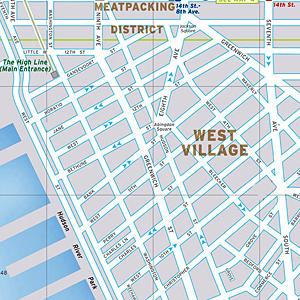 The West Village is a neighborhood within the larger neighborhood of Greenwich Village, which was designated as a New York City historic district in 1969 and expanded since then. Situated on the island of Manhattan, it is bounded by the Hudson River on the west and Sixth Avenue on the east, extending from 14th Street south to Houston Street. Bordering neighborhoods include Chelsea to the north, the South Village and Hudson Square to the south, and Greenwich Village proper to the east. The neighborhood is primarily residential, with many small shops, restaurants, and services lining the streets.
The West Village is a neighborhood within the larger neighborhood of Greenwich Village, which was designated as a New York City historic district in 1969 and expanded since then. Situated on the island of Manhattan, it is bounded by the Hudson River on the west and Sixth Avenue on the east, extending from 14th Street south to Houston Street. Bordering neighborhoods include Chelsea to the north, the South Village and Hudson Square to the south, and Greenwich Village proper to the east. The neighborhood is primarily residential, with many small shops, restaurants, and services lining the streets.
Notable features of the West Village include the Whitney Museum; Westbeth Artists Housing, one of the first examples of adaptive reuse of industrial buildings (in this case, Bell Laboratories) for artists and residents in the United States; the High Line, the elevated train tracks that once served businesses in the area, long abandoned and converted into a very popular public park; and other beautiful parks including Abingdon Square, Jackson Square, St. Vincent’s, the AIDS Memorial, Hudson River Park along the water, and the newly opened, fanciful Little Island.
The Meatpacking District—also known as the Gansevoort Historic District—is at the north end of the West Village. Markets have existed in the district since the 1840s, and a number of meat-packing companies still operate here. Beginning in the 1990s, bars, restaurants, and boutiques have become far more common.
However, the appeal of the West Village extends well beyond its physical attributes of narrow cobblestone streets, abundant greenery, and low-rise, early-nineteenth-century architecture. Since 1916, when it first became known as “Little Bohemia,” the West Village has nurtured generations of artists and activists who found refuge here from the greater metropolis of Manhattan. Names of past residents that quickly come to mind are Edna St. Vincent Millay and James Baldwin, Diane Arbus and Edward Albee. However, these are just the few of those who cemented the character of this neighborhood. In the pages of this book, you will read ninety interviews of those who still reflect the heartbeat of this unique community known as the West Village.
